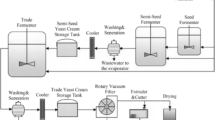Abstract
Cross-flow microfiltration is an important step in separating Baker’s yeast (Saccharomyces cerevisiae) from aqueous suspension in many processes. However the permeate flux often declines rapidly due to colloidal fouling of membranes and concentration polarisation. The present work explores the possibility of maintaining acceptable permeate flux by co-current sparging of gas along with the feed, which would scour away colloidal deposits and reduce concentration polarisation of membranes. In this work, both washed and unwashed yeast were used to study the effect of washing to reduce protein fouling of membranes. It was found that permeate flux increased by 45% for liquid throughput of 75 kg/h for a feed concentration of 2.0 kg/m3 of washed yeast as compared with unwashed yeast suspension without gas sparging. For washed yeast suspension, the increase in gas flow rate from 0.5 lpm to 1.5 lpm (30 l/h to 90 l/h) had beneficial effect on permeate flux. It is concluded that in the present case, the gas flow rate should be less than or equal to the liquid flow rate for enhancement of permeates flux.




Similar content being viewed by others
References
Cui ZF, Wright KIT (1994) Gas-liquid two-phase cross-flow ultrafiltration of BSA and dextran solutions. J Membrane Sci 90:183–189
Cui ZF, Wright KIT (1996) Flux enhancements with gas sparging in downwards crossflow ultrafiltration: performance and mechanism. J Membrane Sci 117:109–116
Bellara SR, Cui ZF, Pepper DS (1996) Gas sparging to enhance flux in ultrafiltration using hollow fibre membranes. J Membrane Sci 121:175–184
Cui ZF, Bellara SR, Homewood P (1997) Airlift crossflow membrane filtration - a feasibility study with dextran ultrafiltration. J Membrane Sci 128:83–91
Cabassud C, Laborie S, Laine JM (1997) How slug flow can improve ultrafiltration flux in organic hollow fibres. J Membrane Sci 128:93–101
Mercier M, Fonade C, Lafforgue-Delorme C (1997) How slug flow can enhance the ultrafiltration flux in mineral tubular membranes. J Membrane Sci 128:103–113
Finnigan SM, Howell JA (1989) The effects of pulsatile flow on ultrafiltration fluxes in a baffled tubular membrane system. Chem Eng Res Des 67: 278–282
Bellhouse BJ, Sobey IJ (1994) Enhanced filtartion using flat membranes and standing vortex waves. Bioseparation 4:127–138
Racz IG, Wassink JG, Klassen R (1986) Mass transfer, fluid flow and membrane properties in flat and corrugated plate hyperfiltration modules. Desalination 60:213–222
Chen V, Fane AG, Fell CJD (1992) The use of anionic surfactants for reducing fouling of ultrafiltration membranes- their effects and optimisation. J Membrane Science 67:249–261
Cui ZF (1993) Experimental investigation on enhancement of crossflow ultrafiltration with air sparging. In: Patterson R (ed) Effective membrane process- New Perspectives. Mech Eng, London, pp 237–245
Wright KIT, Cui ZF (1994) Identification of enzyme activity loss caused by gas bubbles. In: Pyle DL (ed) Separation for Biotechnology 3, Royal Society for Chemistry, pp 579–585
Marshall AD, Munro PA, Tragardh G (1993) The effect of protein fouling in microfiltration and ultrafiltration on permeate flux, protein retention and selectivity: A literature review 91:65–108
Fane AG, Fell CJD, McDonogh RM, Suki A, Waters AG (1983) in Proceedings of the eleventh Australian Conference on Chemical Engineering (Chemeca 83), Brisbane, 4–7 September, pp 729–737
Li QY, Ghosh R, Bellara SR, Cui ZF, Pepper DS (1998) Enhancement of ultrafiltration by gas sparging with flat sheet membrane modules. Separation and Purification Technology 14:79–83
Bachhin P, Aimar P, Sanchez V (1995) Model for Colloidal Fouling of membranes. AIChE J 41:368–376
Hashim MA, Sen Gupta B (1997) A study on the effect of operating parameters on the cross-flow microfiltration of yeasts. Bioseparation 7:17–23
Sen Gupta B, Hashim MA, Ramachandran KB, Sen Gupta I, Cui ZF (2005) The effect of gas sparging in cross-flow microfiltration of 2,3-Butanediol broth, Eng. In Lfe Sciences 5:54–58
Author information
Authors and Affiliations
Corresponding author
Rights and permissions
About this article
Cite this article
Gupta, B.S., Hasan, S., Hashim, M.A. et al. Effects of colloidal fouling and gas sparging on microfiltration of yeast suspension. Bioprocess Biosyst Eng 27, 407–413 (2005). https://doi.org/10.1007/s00449-005-0012-5
Received:
Accepted:
Published:
Issue Date:
DOI: https://doi.org/10.1007/s00449-005-0012-5




